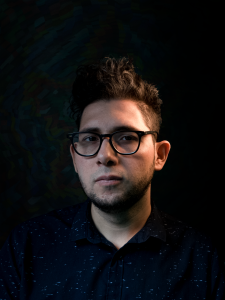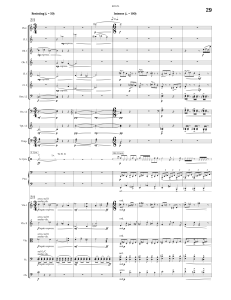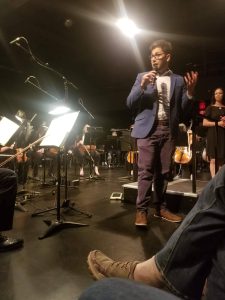CMC Ontario Regional Director Joseph Glaser sat down with HPO composer fellow, Luis Ramirez to discuss his participation in the Hamilton Philharmonic Orchestra Composer Fellowship program.
The program was launched in collaboration with the Ontario Region of the Canadian Music Centre in our 18-19 Season. The program is aimed at connecting early career composers with professionals in the orchestral world to nurture and develop new skills through mentorship and the creation of a new work.
On June 26th, 2022, the Hamilton Philharmonic Orchestra Premiered Luis’s work Koatl conducted by Gary Kulesha as the culmination of Luis’s fellowship with the orchestra.
 Joseph Glaser: Tell me a bit about yourself, how did you get into music?
Joseph Glaser: Tell me a bit about yourself, how did you get into music?
Luis Ramirez: I’ve been playing piano since I was six, and for much of my life I pursued music along the path to becoming a concert pianist. My parents put me in piano lessons and they allowed me keep exploring my relationship to music as much as I wanted. It just so happened that when I was ready to enter University, a newly formed Bachelor of Music program in my hometown of Aguascalientes in Mexico opened up and I got accepted there. In the middle of that program, I got an invitation to study at Brandon University with Alexander Tselyakov. Throughout these studies I always thought I wanted to be a pianist, but once I finished my Master’s in piano performance I realized that my real love was music in general and piano had just been my medium to engage with it. Once I made that realization, I consequently became more interested in composition and so did another Master’s degree with [CMC Associate Composer] Pat Carrabré in Composition at Brandon University as well. After that I came to Toronto to pursue my doctoral studies with [CMC Associate Composer] Randolph Peters [at York University], where I’m finishing the fourth year of my studies and navigating the world of freelance composition.
JG: You’ve had this journey from Aguascalientes to Brandon and now Toronto, can you touch on how those different scenes have felt? What are some similarities and some differences?
LR: At first, when I started to become aware of the differences, I was so confused. Growing up in Mexico, there is not a lot of support for the arts, so there is not a big scene in classical music. There is a scene, but because of how things have played out historically, some of the teachers went to study in Europe in the beginning and middle of the last century and the European modernist style has permeated the classical music scene there. I had a close friend who was studying composition in Mexico and he was telling me about the things he was doing and it was very much in this modernist style that I wasn’t really fond of. This left an impression on me as a 15–16-year-old, I thought that that was all the music being composed today. That only changed when I came to Canada and especially when I had exposure to the Winnipeg Symphony New Music Festival where they programmed all this Canadian music that had a completely different approach to what I was taught, and that’s when I fell in love with it. It finally clicked that this is also a style of music that’s being done and I saw myself in that music. I was exposed to many more different styles, like minimalist music, postmodern music, etc. I started to be able to understand a place for myself as a composer, which was a big relief to me. The Winnipeg Symphony New Music Festival was a big revelation for me.
With Toronto, I feel like I’m just getting to know the scene. The major difference, of course, is that there’s so much going on here. In Brandon, there were so few opportunities in terms of concerts, there was just what was at the University. Here in Toronto, there are things going on all the time: festivals, workshops, etc. Which is good because it means I can be a bit pickier with what I go to. And of course, there’s also a lot of the more traditional classical music happening as well with the Toronto Symphony Orchestra and other large orchestras which play the repertoire which is still very dear to me. It’s definitely very inspiring to be around all that, but on the other hand, in Winnipeg they have the advantage of the New Music Festival being a major event. Both have benefits and drawbacks.
 JG: Tell me a bit about the piece. How did you translate this mythological story into music?
JG: Tell me a bit about the piece. How did you translate this mythological story into music?
LR: I’ve been wanting to make a piece that follows [Joseph Cambell’s] Hero’s Journey framework for a while. In that framework there is a hero that goes on an adventure, faces some obstacles, and learns valuable lessons from that experience and ends up being better because of the experience and succeeds over the challenges. It’s a very common template across media. I wanted to incorporate the myth of the feathered snake, partly because the title of the concert, Dragon Unfolding, suggested to me this myth to use with my hero’s journey idea. It ended up working out perfectly because the feathered snake is a myth that’s common across Latin America from pre-Hispanic times, known in the Aztec culture as Quetzalcoatl and in the Mayan culture as Kukulcan. This deity is known for being a trickster god and part of the myth is that there is a reward for conquering it. I thought that the concept of the trickster and the reward aligned with another idea which was dear to me at the time, the idea of facing your own shadow. That idea is often referenced in psychology books: you need to face your own shadow to better understand yourself. So, this combination of the mythological and personal seemed like the ideal way for me depict the hero’s journey. The program of the piece involves the hero who goes into the underworld and discovers this being, the Koatl, and at first they are intrigued by it, wanting to approach before the being attacks back and starts chasing them. The music highlights the pain in this scenario and uses some distortion of time to depict this chase until the hero understands that in order to escape, they must face their fears and to confront and embrace the snake while the music coalesces into a sense of self-actualization. Joseph Cambell has a great quote: “The cave you fear to enter contains the very treasure you seek” and this piece depicts exactly that.
JG: I know that this is not the only piece of yours to reference Mexican folklore or mythology. While a lot of your music also doesn’t, I was wondering how important it is for you to have that reference in your music?
LR: It’s only been in hindsight that I realize that I have multiple paths in my music. My works for chamber ensembles tend to focus on stories from or about the internet and internet culture, and I really enjoy exploring that world, but when I first had a chance to write for orchestra, I named the piece Chido. Chido is a Mexican slang word, and in that piece, I was going after depicting the culture and feeling of urban Mexico. I was really proud of the way that I was able to use the orchestra to reflect that. The richness in colour of the orchestra made me realize what a beautiful canvas it is for displaying folklore. So, at that point, I subconsciously made the decision that when I write for orchestra, I want to reference Mexican folklore. It’s a beautiful way for me to not only see representation for aspects of the culture that I grew up in but also to display the richness and depth of the stories and traditions of Mexico. There’s a lot references that were common knowledge to me growing up in Mexico that people here are unfamiliar with. Additionally, with my music, it’s not like a Wikipedia article just listing the facts, instead it’s more storytelling and cinematography, showing the audience about the subject instead of just defining it. My three last orchestral pieces all do that, and it’s something I’m interested in continuing because I find it very inspiring and exciting to use the orchestra for this purpose. I also get very good feedback about it, for example my latest piece which is about the Piñata was performed by the TSO and some people didn’t know what a piñata is, and one of them told me “I didn’t know what it was, but it sounds really fun based on your music”. That feedback is one of the most motivating things for me.
JG: What was it like working with the HPO? 
LR: It was one of the most important stepping stones for me as a composer because I got to know the inner workings of an orchestra. Abigail [Richardson-Schulte], the Composer-in-Residence, took me around to meet the staff and I got to know what each of them does. Getting to know the people involved in an organization, even just knowing that there are people involved and putting a face to their name, made me realize the extent of the operation that goes on in an organization like that. It helped me understand what my role as a composer can be in the future with an orchestra. More than anything, being at rehearsals, talking to the conductor and understanding the dynamics of that situation was super crucial. We had Abigail taking us by the hand throughout this process, speaking to us outside of rehearsal, having us speak to donors. In the course of the fellowship, I gained not only musical skills, but also interpersonal skills, which are super important to the role. All of those skills were put to the test when I subsequently had a piece played by the Calgary Philharmonic and that time it was all on me! It was my first professional performance that wasn’t part of a learning or mentorship opportunity so I had to apply all the things I had learned earlier in the year; how to behave in rehearsals, talking to musicians, talking to donors, etc. I was super grateful that I got to have the “trial” at the HPO with the help of Abigail because the experience with Calgary ended up going really well. I navigated those dynamics much better because I had this opportunity.
JG: What are some takeaways you have from the experience?
LR: It’s very important for me to be able to make sense of the things I am engaging with and this experience got me to understand what an orchestra is as a whole. Talking to people in all sorts of roles, their day-to-day operation, and understanding where the roles fit in the organization was very inspiring to me. Talking to Gemma and understanding how much dedication she puts into preparing the score. Seeing Abigail give numerous, inspiring, pre-concert and supplementary talks. All these things that I sort of knew were considerations, but didn’t understand fully until I saw them displayed. It’s inspiring, because it shows me an example of how the skills that I’ve developed over the course of my education can be put to use. I don’t think I had seen a concrete example of a role that made use of all of my skills before, and not just my composition skills. This program allowed me to see a way in which all of my skills as a whole musician come together in the role of Composer-in-Residence. It allowed me to connect with that role and to see myself in a role like that at some point in the future.

